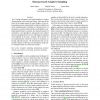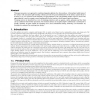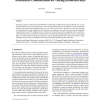7 search results - page 1 / 2 » Parallel Ray Tracing with 5D Adaptive Subdivision |
119
Voted
WSCG
2001
15 years 1 months ago
2001
We present strategies for parallelising ray tracing based on 5D adaptive subdivision. Our goals are to obtain good speed-up and to efficiently balance the load between the process...
103
click to vote
GRAPHICSINTERFACE
2003
15 years 1 months ago
2003
Ray tracing techniques need supersampling to reduce aliasing and/or noise in the final image. Since not all the pixels in the image require the same number of rays, supersampling...
100
Voted
TVCG
1998
14 years 12 months ago
1998
This paper presents a new approach to rendering triangular algebraic free form surfaces. A hierarchical subdivision of the surface with associated tight bounding volumes provides ...
99
Voted
EGH
2010
Springer
14 years 10 months ago
2010
Springer
This paper proposes a massively parallel hardware architecture for efficient tracing of incoherent rays, e.g. for global illumination. The general approach is centered around hier...
113
click to vote
RT
1998
Springer
15 years 4 months ago
1998
Springer
The paper presents a single-pass, view-dependent method to solve the general rendering equation, using a combined finite element and random walk approach. Applying finite element t...



